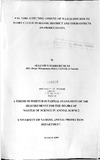| dc.description.abstract | To study the factors affecting amount of water offered to dairy cattle and their effects on
productivity, 20 smallholder dairy farmers in Kiambu District were randomly selected.
Data collected once fortnightly for 11 months was analysed to study the impact of water
on offer on productivity. Data was collected on source of water (on- or off-farm), water
storage, distance to water source (categorised as 1) 0-200m, 2) 200-1000m or 3) >lkm),
watering frequency (continuous or non-continuous watering), mode of presentation
(categorised as water troughs of 1 « 100), or 2 (> 100 litres)), means of water transport
categorised as none needed. manual, or carts/wheelbarrows/donkeys/bicycles. Total
amount of feed offered, water offered. milk yield, live weight and condition score were
also monitored.
Mean amount of water offered per farm per day was 134 I. or 35.6 11300kg LWI day.
However, the variability was high (range of 7 - 108 11300kg LW/day). Of the farms
surveyed, 60% had on-farm water source, which was within a radius of 200m. 40%
trekked between 0.2 - 2.5km to fetch water for livestock. Only 25% had water piped
directly to the water trough. 55% carried water manually by bucket while 20% used
draught power or bicycle or wheelbarrows to transport water. Small water troughs (20-1-
buckets) were used in 25% of the farms surveyed to water dairy cattle. 50% of the farms
practised non-continuous watering and 55% had no water storage facilities.
Analysis of the data showed that source, distance to source, water transport means, water
storage facilities, watering frequency, volume of water trough significantly affected the
amount of water offered/day to dairy cattle (P<0.05). Distance to water source was
related to quantity of water offered. with mean quantities of 43. 23 and 21 1/300kg LW
being offered to animals in the distance categories 1-3 cited above. Cows with on-farm
water source received 43 1compared to 22 1offered in farms with off-farm water source.
Mean quantities of 52. 30 and 25 1/300 kg lwt were offered to dairy cattle in farms with
water piped directly to water trough, manual-hand bucket and those using
draught/bicycle/wheelbarrow respectively. Watering frequency influenced water on
offer with mean quantities of 491/300 kg lwt/day (continuous watering) and 21-1/300 kg
lwt/day (non-continuous watering). Small water troughs restricted the amount of water
on offer/day (21 1I300 kg lwt) compared to 39 1I300 kg 1wt /day offered in farms with
large water troughs.
Dairy cows were offered a variety of feeds. Napier and other types of grasses were the
main feeds constituting more than half (1.581100 kg lwt) of the total feed offered. Dry
maize stover was second to napier/grasses in importance with an average of 0.567 kg /
100 kg lwt per day. Concentrates were offered in all farms to lactating cows at an
average of 0.4855 kg /100 kg lwt per day. These included commercial dairy meal,
cotton seed cake, bone meal, maize bran. maize germ. wheat bran and poultry litter.
It was observed that dairy cattle in farms with on-farm water source, large water troughs,
practicing continuous watering and those with water storage facilities were offered high
amounts of water and produced significantly (P<0.05) more mille In addition, these
farms were offered high amounts of concentrates and napier grass. In farms where high
amount of dry maize stover was offered to dairy cattle, coupled with low water on offer,
low milk yields were realised. This was observed in farms with small water troughs, offfarm
water source and farms without piped water.
General linear model analysis of the data indicated that the amount of water offered
(l/300kg LW/day), age, parity, body weight stage of lactation, body condition score and
dry matter on offer had a significant effect on milk yield. Increasing amount of water
offered increased milk yield. In conclusion. high amount of water. concentrates and
napier/grass on offer resulted in high milk yields. These results highlight the increasing
importance of ensuring adequate provision of drinking water as milk yields in dairy
cows increase. In this context smallholder dairy farmers in Kiambu District should be
advised to increase the amount of water offered to dairy cattle from the average 35
litres/300 kg LW/day currently offered to at least the recommended 60 litres per day .. | en |

